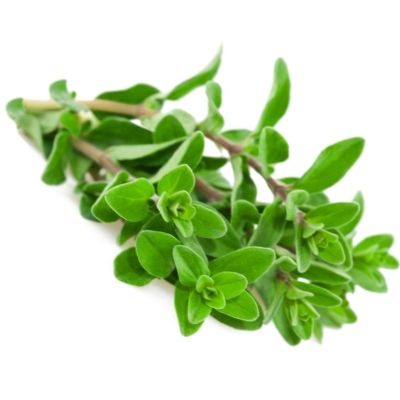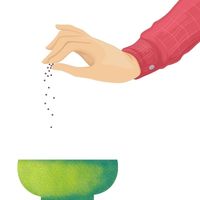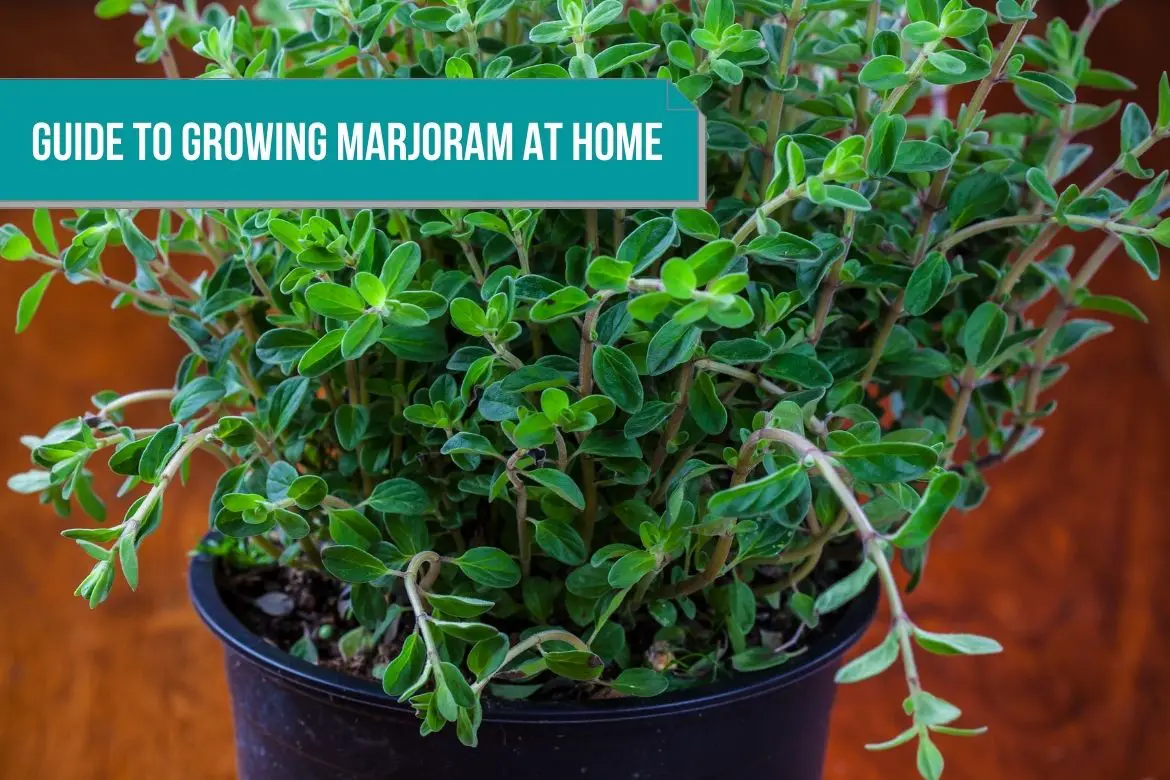
Botanical name : Origanum majorana
Flavor Profile : Like sweeter version of oregano. Floral and lightly spicy. Undertones of clove and citrus.
Marjoram is an aromatic perennial herbaceous herb. Leaf, seed, and essential oil of plants are used in a variety of ways.
The leaves of this plant are traditionally used fresh or dried and are highly valued as a seasoning for food. They can be used as garnish and are added to salads and vinegar. For sachets and potpourri, dried flowering tops are commonly used. The aromatic seed of marjoram can also be used in confectionery.
Marjoram and oregano are often confused as both are similar not just in appearance, but also in taste, though marjoram has a richer flavor without the bitterness of oregano. The mild, sweet flavor of sweet marjoram makes chefs prefer it over the more common oregano.
Marjoram, also known as sweet marjoram is the “sleeper” of the culinary herb garden. Among the other herbs, it grows quietly without drawing attention to itself, instead reaching the kitchen and blowing away its competitors.
This is definitely something you should have in your garden if you enjoy growing herbs and cooking with them.
It is not suitable for long cooking processes as the flavor of marjoram decreases with prolonged heat exposure.
Health benefits of Marjoram
Like a lot of other herbs, marjoram is also considered as a great antioxidant. Because of various compounds present in marjoram, it is is effective at scavenging free radicals from food.
Marjoram may have beneficial effects on hormonal health, particularly for women. As it may help in regulating menstrual cycles.
Several studies have demonstrated that marjoram is anxiolytic, or anxiety-reducing.
Marjoram is antimicrobial and anti-inflammatory.
Due to its antiulcerogenic properties, it decreases ulcers, basal gastric secretion, and acid output, and replenishes the depleted mucus on the gastric wall.
Marjoram is high in calcium, magnesium, potassium, and vitamin A, vitamin K and vitamin C.
How to grow Marjoram indoors
Origanum majorana (sweet marjoram) is a perennial herb ( but can be grown as annual) originating in the Mediterranean region. The plant grows well in Zones 9 to 11, but will survive in cooler climates if protected during the winter.
Marjoram comes in three general varieties: the sweet marjoram, pot marjoram and wild marjoram.
Late winter or early spring is a good season for planting marjoram plant. Plant it after the threat of frost has passed. Indoor container gardening gives you a little bit of flexibility though. You can even plant the marjoram indoors 8 weeks before the last frost.
Difference between marjoram and oregano
Sweet marjoram is sometimes mistaken for oregano (Origanum vulgare), which is a different species altogether and less flavorful than sweet marjoram.
Sweet marjoram is characterized by broad leaves that are heart-shaped and relatively smooth. On the other hand, oregano leaves have narrower, lance-shaped, somewhat downy foliage.
Marjoram crossed with oregano yields “Hardy Sweet” marjoram (Origanum majoricum), which is sometimes called “Italian oregano”.
Plant size

1 – 2 feet ( 12 – 24 inches OR 30 – 60 cm )
Container / pot Size

A container size of 6 inches which is 6 inches deep is enough for a single marjoram plant.
However, the size of the required pot will increase in case you plant to pot multiple marjoram plants.
A 12 to 14 inch pot is recommended in case you plan to grow a bush of multiple marjoram plants.
Refer how to choose the right container for your indoor plants for more details.
Sunlight

Full Sun. Although it can survive partial shade but half a day of full sun will improve flower color and aroma.
While germination, marjoram seedlings grow best at a temperature of 70 degree Fahrenheit (21 degree Celsius).
A grown Marjoram plant can survive in a temperature range of 70-90 degrees Fahrenheit (21-32 degrees Celsius).
For best results in growing marjoram indoors, place the container near a large south or north facing window or windowsills. Or you can place the container near east or west facing windows or windowsills. Placing under a skylight under direct sun is also a good option.
Refer Best locations and Light requirements for indoor plants for more details.
Soil

Well drained, loose, deep and rich in organic matter potting mix.
If you are stuck with garden soil, make sure that the soil is sandy loam, well drained and loose.
You can mix a little bit of horticultural sand with the potting mix. Adding some compost with the potting mix is also a good option.
Refer types of soils for gardening for more details.
Marjoram thrive on a soil with pH range 6.5 to 7.5.
Please refer How to get the right potting mix for your container plant for more details.
Sowing

Marjoram can be grown by seeds, cutting or root division.
For growing marjoram with seeds, sow the seed in the potting mix and water the pot. The seeds are very small (almost the size of mustard seeds). Don’t worry about the seed sowing depth. just sprinkle the seeds over the soil with a pinch. you should “overseed” as sometimes small seeds have low rate of germination. hence putting many seeds is a good idea.
After putting the seeds, you can press the seeds gently down by using something flat (may be bottom of a glass or cup).
Put the pot in a spot with sunlight.
In almost 3-4 days, you will see small seedlings germinating from the soil. Within 10-12 days, you will be able to see seedlings with true leaves.
In 2-3 weeks you will have a 2 inch small plant with 7-8 leaves.
In case you plan to plant marjoram in individual containers, 3-4 week old marjoram plant is good enough to be transplanted.
Although growing marjoram from seeds is considered as tricky, you must try it in at least one container.
For planting marjoram from stem cutting, the process is pretty straight forward. However, the key is to be fast as soft cuttings might dry up soon.
Cut a stem at least 10 cm longs. Snip the stem right at the node (the leaf joint). Remove the lower leaves along with the soft tip stem and leaf section. At the end you will have a stem which has a trimmed top (which has soft leaves), and some leaves in the middle.
You can dip the stem in a rooting hormone but its optional. Plant the stem in the potting soil. keep the soil moist.
Watering

You might not have to water the marjoram plant a lot in both germination and established phase.
However, keep the soil moist at all times. Water whenever the soil feels dry to the touch.
Marjoram is quite a drought resistant plant. Once the marjoram plant is established, you can reduce the frequency of watering. May be twice or thrice every week. This also depends on the climate. The whole idea is to not let the soil completely dry.
Do not over water the pot. Waterlogged soil is not good for marjoram plant as it will cause root rot.
Quick tip: Water the plant from the side of the pot. Do not water from overhead. Wetting the leaves will cause fungal diseases on the plant leaves.
Make some drainage holes at the bottom of the container to drain the water just in case excess water is used while watering marjoram.
Refer How to make drainage holes on potting container for more details.
Harvesting

Plants need two to three months to grow strong enough to be harvested. Whenever possible, cut off sprigs from the plant, but don’t take over a third at a time.
When you are harvesting marjoram for drying purposes, wait until it blooms and snap off whole sprigs before they flower, leaving at least two-thirds of the plant intact so it can regrow.
Quick tip: waiting for the flower bulbs to form and then harvesting the leaves just before the flowering will give you the best flavor.
Plant care

Prune the plant regularly to promote more growth of the marjoram plant.
Change the soil of the container every 2-3 years.
In case the leaves are infected by fungus remove them. Do not add those leaves to the composts where the fungus can survive..
While transplanting, snip off the tips of the plant to promote new growth.
Trimming the roots once every year is also a good practice, specially for potted plants. This will remove old and dead roots and make some space for new roots.
SUBSTITUTES FOR MARJORAM IN THE KITCHEN
- Thyme
- Sage
- Oregano
- Basil
- Savory
How to keep Marjoram fresh
Fresh marjoram leaves can be stored in refrigerator for almost 2 weeks. Keep it in a sealed container or zip lock bag.
You can even freeze store marjoram for 4-6 months. Freeze whole leaves or chopped leaves in ice tray.
It is ideal to dry marjoram because its flavor retains better than that of a lot of other dried herbs
Please refer to how to store herbs and spices for more details.
How to use Marjoram in the kitchen
Marjoram is an essential component of Italian, Greek and French cuisine.
The herb sweet marjoram is traditionally used in poultry stuffing.
The potency of dried marjoram is greater than that of fresh marjoram.
It is common to combine grated or ground roots with cream, mayonnaise, mustard, oil, salt, vinegar, or yogurt.
It adds a complex floral-sweet flavor to many dishes.
Dishes that go well with Marjoram : Salads, liquors, teas, soups, stew, dessert, marinade, sauces, dressing, vinegar, cheese mixes, casserole.
Preparation of Marjoram for food : Marjoram is used fresh a whole or chopped. Use it at the end of cooking or just before serving the food.
It is also used in dried form.
Pairing Marjoram with food
Seasonings that go well with Marjoram :
Thyme, parsley, nutmeg, horseradish, savory, garlic, juniper, chives, oregano, bay leaf, pepper.
Fruits and Vegetables that go well with Marjoram :
Potatoes ( White Potato, Red Potato, Russet Potato, Purple Potato ), tomatoes, carrots, beets, celery, cabbage (red cabbage, green cabbage), Mushrooms (Enoki Mushroom, Morel Mushroom, White Mushroom / Button mushroom, Cremini Mushroom, Portabella Mushroom, Shiitake Mushroom, Maitake Mushroom, Chanterelle Mushrooms, Oyster Mushroom), pomegranate, cauliflower, spinach, apples, peas, cherries, asparagus, squash ( Spaghetti Squash, Snake Gourd, Indian Squash, Crookneck Squash, Butternut Squash, Banana Squash, Acorn Squash ), eggplant, apricots, peppers (green pepper, yellow pepper, red pepper) , oranges.
Proteins that go well with Marjoram :
Fish and seafood, Eggs, beef, cheeses, turkey, sausages, chicken.

